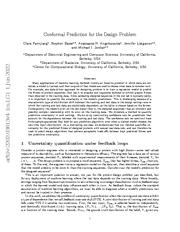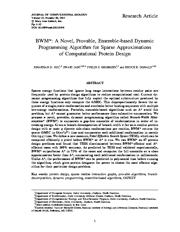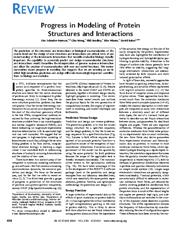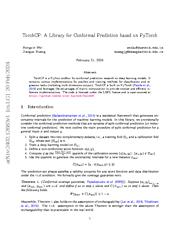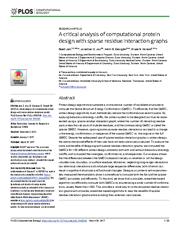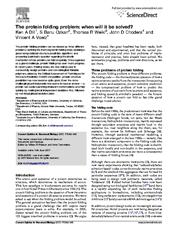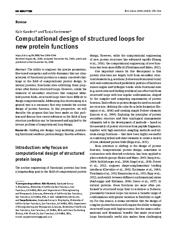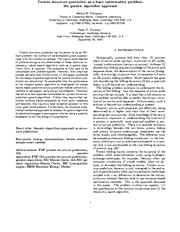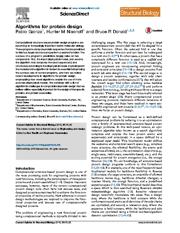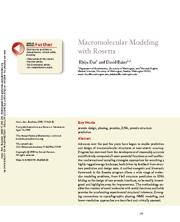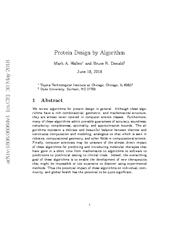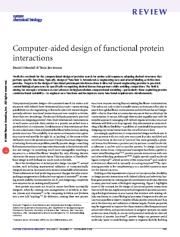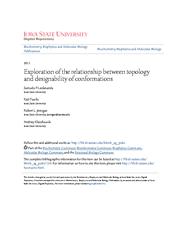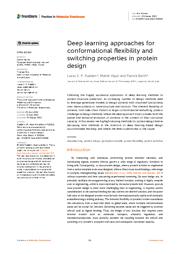A copy of this work was available on the public web and has been preserved in the Wayback Machine. The capture dates from 2022; you can also visit the original URL.
The file type is application/pdf.
Filters
Conformal prediction for the design problem
[article]
2022
arXiv
pre-print
For example, one data-driven approach for designing proteins is to train a regression model to predict the fitness of protein sequences, then use it to propose new sequences believed to exhibit greater ...
As a motivating use case, we demonstrate with several real data sets how our method quantifies uncertainty for the predicted fitness of designed proteins, and can therefore be used to select design algorithms ...
S.B. was supported by the Foundations of Data Science Institute and the Simons Institute. ...
arXiv:2202.03613v4
fatcat:oeg7axxf6rfyzlsvvnv5ambffa
BWM*: A Novel, Provable, Ensemble-Based Dynamic Programming Algorithm for Sparse Approximations of Computational Protein Design
[chapter]
2015
Lecture Notes in Computer Science
Unlike A*, the performance of BWM* can be predicted in polynomial time before running the algorithm, which gives protein designers the power to choose the most efficient algorithm for their particular ...
design problem. ...
ACKNOWLEDGMENTS We thank all members of the Donald lab, and Prof. Jane Richardson and Prof. David Richardson for helpful discussion and comments. ...
doi:10.1007/978-3-319-16706-0_16
fatcat:qkyqw6bvmjeghez5zd56cocvw4
Progress in Modeling of Protein Structures and Interactions
2005
Science
The prediction of the structures and interactions of biological macromolecules at the atomic level and the design of new structures and interactions are critical tests of our understanding of the interatomic ...
Equally important, the capability to accurately predict and design macromolecular structures and interactions would streamline the interpretation of genome sequence information and allow the creation of ...
Prediction Versus Design Prediction and design are inverse problems: The prediction problem is to find the lowest energy structure for a specified sequence, and the design problem, to find the lowest energy ...
doi:10.1126/science.1112160
pmid:16254179
fatcat:7sgl24kymbdgxb35cxfyeerzme
TorchCP: A Library for Conformal Prediction based on PyTorch
[article]
2024
arXiv
pre-print
TorchCP is a Python toolbox for conformal prediction research on deep learning models. ...
It contains various implementations for posthoc and training methods for classification and regression tasks (including multi-dimension output). ...
For regression problems, the main research point is the design of conformal prediction algorithms (Gibbs and Candes, 2021; Lei et al., 2018) , some of which involve new training methods (Romano et al ...
arXiv:2402.12683v1
fatcat:aj2ulw4enva7fkxhffjmfrkne4
A critical analysis of computational protein design with sparse residue interaction graphs
2017
PLoS Computational Biology
To analyze the costs and benefits of designing with sparse residue interaction graphs, we computed the GMECs for 136 different protein design problems both with and without distance and energy cutoffs, ...
To efficiently find the GMEC, protein design algorithms must methodically reduce the conformational search space. ...
Acknowledgments The authors thank all members of the Donald lab, and Prof. Jane S. Richardson and Prof. David. C. Richardson for helpful discussion and comments. ...
doi:10.1371/journal.pcbi.1005346
pmid:28358804
pmcid:PMC5391103
fatcat:hnskkwydizgulapemnldveisaq
The protein folding problem: when will it be solved?
2007
Current Opinion in Structural Biology
Folding codes are now being used to successfully design proteins and non-biological foldable polymers; aided by the Critical Assessment of Techniques for Structure Prediction (CASP) competition, protein ...
The protein folding problem can be viewed as three different problems: defining the thermodynamic folding code; devising a good computational structure prediction algorithm; and answering Levinthal's question ...
Acknowledgements We thank Kingshuk Ghosh for his assistance and comments. We appreciate the support of National Institutes of Health grant GM 34993 and the Sandler Foundation. ...
doi:10.1016/j.sbi.2007.06.001
pmid:17572080
fatcat:cdrusrnmxfg6thyhjrkcfxgdsm
Computational design of structured loops for new protein functions
2019
Biological chemistry
problem of computational loop design. ...
In this perspective, we will describe the progress that has been made on this problem and discuss how recent advances in the field of loop structure prediction can be harnessed and applied to the inverse ...
Acknowledgments: We would like to thank Matt Jacobson for insightful comments on the manuscript. ...
doi:10.1515/hsz-2018-0348
pmid:30676995
pmcid:PMC6530579
fatcat:y6zg2d5skrdwdhtzxj2t2fsaxq
Protein Structure Prediction as a Hard Optimization Problem: The Genetic Algorithm Approach
1997
Molecular Simulation
In this paper, guidelines for the design of genetic algorithms for protein structure prediction are determined. ...
Protein structure prediction can be shown to be an NPhard problem; the number of conformations grows exponentially with the number of residues. ...
In the present paper, we focus on the design of a good conformational search strategy for the problem, leaving the discussion of the best choice of energy functions for protein structure prediction to ...
doi:10.1080/08927029708024151
fatcat:oodstzimbveqtjolpgqgkbz57e
Protein structure prediction as a hard optimization problem: the genetic algorithm approach
[article]
1997
arXiv
pre-print
In this paper, guidelines for the design of genetic algorithms for protein structure prediction are determined. ...
Protein structure prediction can be shown to be an NP-hard problem; the number of conformations grows exponentially with the number of residues. ...
In the present paper, we focus on the design of a good conformational search strategy for the problem, leaving the discussion of the best choice of energy functions for protein structure prediction to ...
arXiv:physics/9708012v1
fatcat:y5xuuaxj3nhf3ks5zh2avs7pza
Algorithms for protein design
2016
Current Opinion in Structural Biology
principle for epitope-focused vaccine design. ...
Improving both the model and the algorithm in tandem is essential to improving the success rate of current programs, and here we review recent developments in algorithms for protein design, emphasizing ...
We thank Marcel Frankel, Anna Lowegard, and Jonathan Jou for comments on the manuscript, as well as Mark A Hallen for helpful discussions. ...
doi:10.1016/j.sbi.2016.03.006
pmid:27086078
pmcid:PMC5065368
fatcat:fdpilhtu3zbrrbnmkc7nvytjri
Macromolecular Modeling with Rosetta
2008
Annual Review of Biochemistry
A unified energetic and kinematic framework in the Rosetta program allows a wide range of molecular modeling problems, from fibril structure prediction to RNA folding to the design of new protein interfaces ...
Advances over the past few years have begun to enable prediction and design of macromolecular structures at near-atomic accuracy. ...
ACKNOWLEDGMENT It it impossible for us to adequately thank the many dozens of wonderful scientists who have contributed to the development of the Rosetta macromolecular modeling program. ...
doi:10.1146/annurev.biochem.77.062906.171838
pmid:18410248
fatcat:fohys2g6rngzjpigbhlpgkmyiq
Protein Design by Algorithm
[article]
2018
arXiv
pre-print
We review algorithms for protein design in general. ...
Finally, computer scientists may be unaware of the almost direct impact of these algorithms for predicting and introducing molecular therapies that have gone in a short time from mathematics to algorithms ...
for helpful comments on this manuscript; and all members of the Donald lab for many helpful discussions on protein design. ...
arXiv:1806.06064v1
fatcat:z3zscidq55avxaoq7xh54cviwe
Computer-aided design of functional protein interactions
2009
Nature Chemical Biology
Predictive methods for the computational design of proteins search for amino acid sequences adopting desired structures that perform specific functions. ...
The field is aiming for strategies to harness recent advances in high-resolution computational modeling-particularly those exploiting protein conformational variability-to engineer new functions and incorporate ...
ACKNOWLEDGMENTS We thank members of the Kortemme group and the Rosetta developers community for many stimulating discussions and important contributions. ...
doi:10.1038/nchembio.251
pmid:19841629
fatcat:mhi7ajt6effchiwvb6ffqcelhm
Exploration of the relationship between topology and designability of conformations
2011
Journal of Chemical Physics
Machine learning algorithms are used to predict the designability of each conformation. ...
Unique conformation giving minimum energy is identified for each sequence and the number of sequences folding to each conformation (designability) is obtained. ...
If the actual designability of the conformation really falls within the predicted range of maximum probability, then the prediction is correct for that conformation. ...
doi:10.1063/1.3596947
pmid:21702580
pmcid:PMC3133807
fatcat:odkmqseqnvfr3kqudtrpjyoblu
Deep learning approaches for conformational flexibility and switching properties in protein design
2022
Frontiers in Molecular Biosciences
In this review, we highlight existing methods for protein design before discussing how methods at the forefront of deep learning-based design accommodate flexibility and where the field could evolve in ...
Following the hugely successful application of deep learning methods to protein structure prediction, an increasing number of design methods seek to leverage generative models to design proteins with improved ...
Acknowledgments The authors would like to thank Matthieu Marfoglia and Chloe A. Fuller for critically reviewing the manuscript and the Barth Lab for thought-provoking discussion. ...
doi:10.3389/fmolb.2022.928534
pmid:36032687
pmcid:PMC9399439
fatcat:nxqcpiyhz5csdlue4xg2h3nun4
« Previous
Showing results 1 — 15 out of 434,096 results

